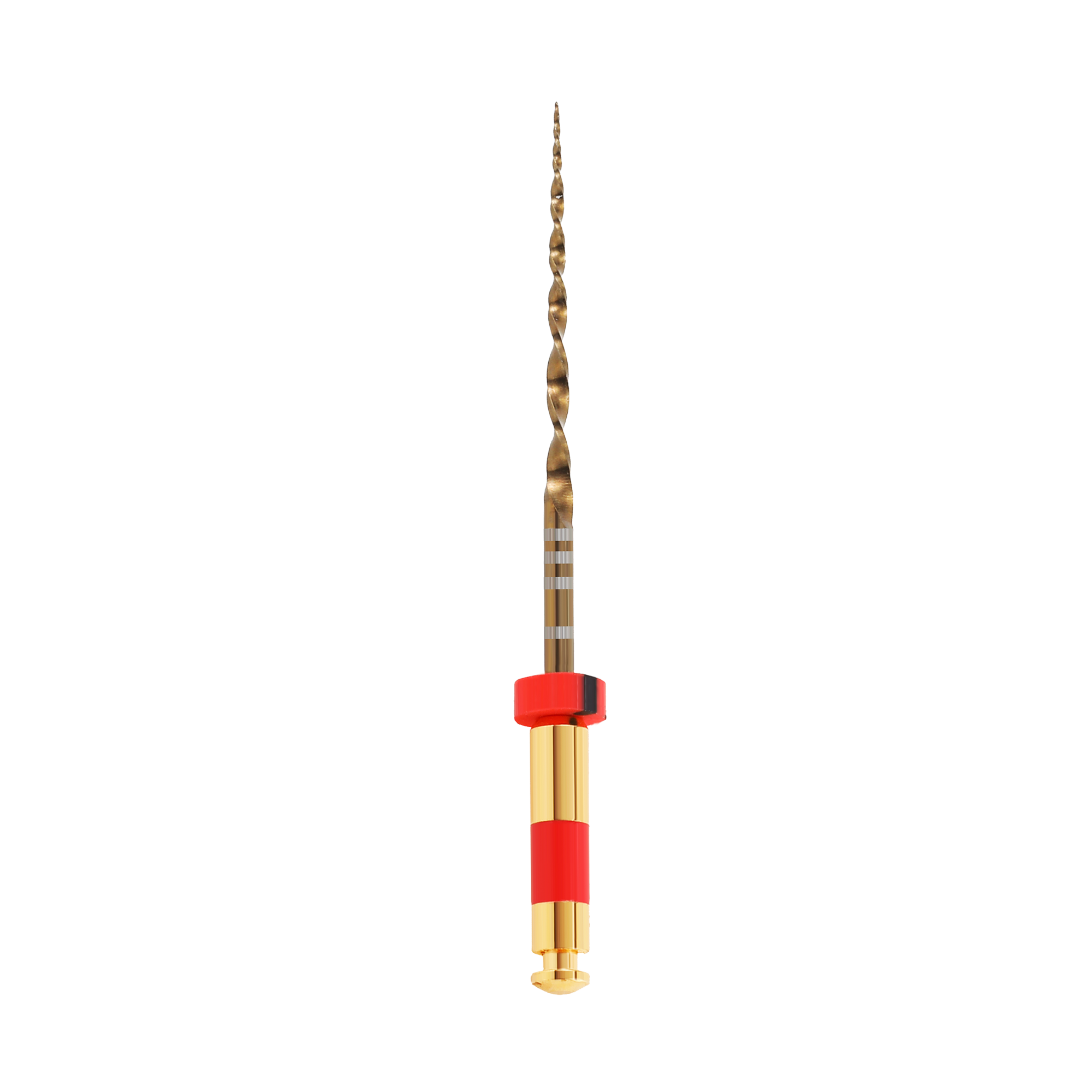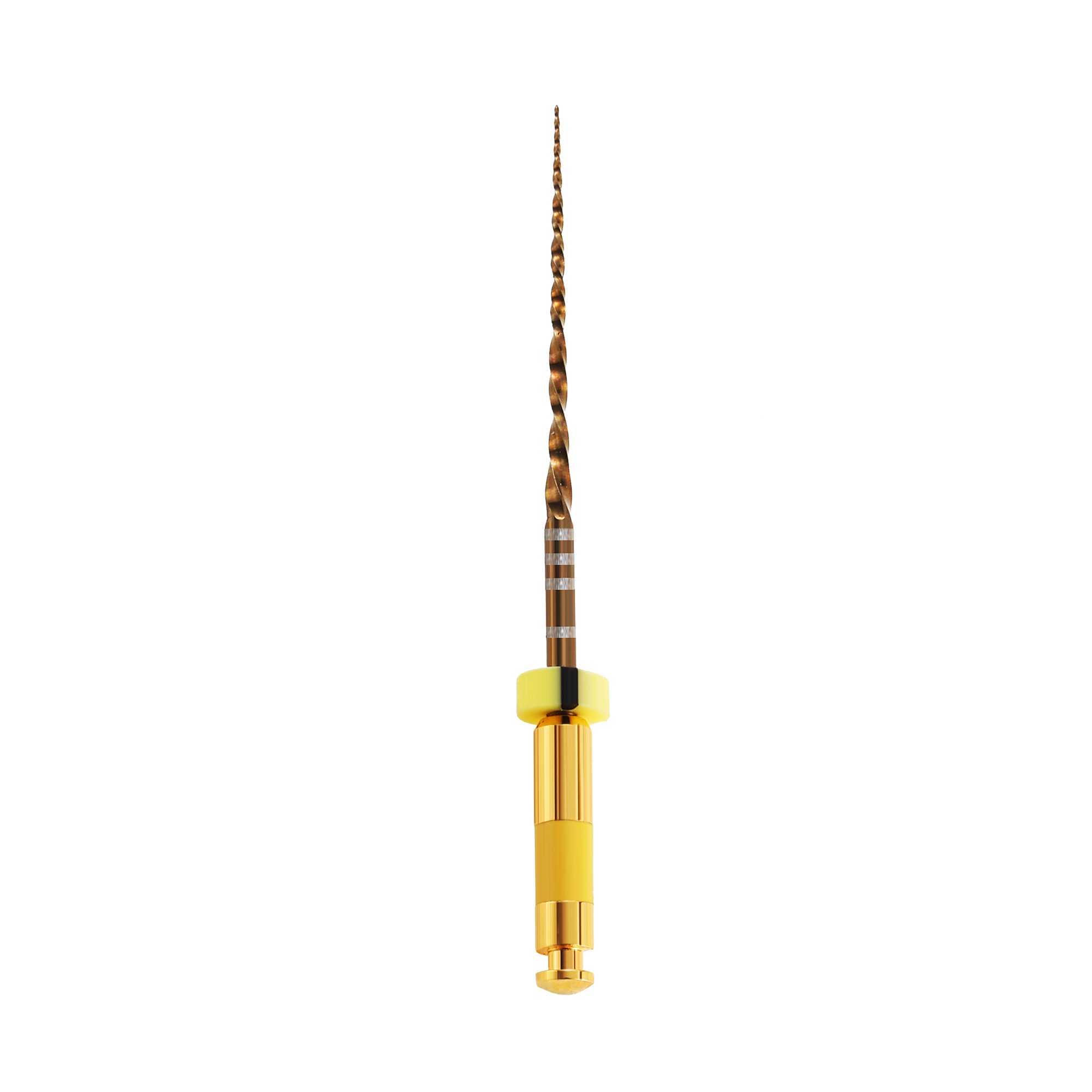ATF4
Treatment
- We provide this product in Silver and Gold, and the gold one has been heat-treated.
- Silver Conventional NiTi, tough blade, great efficiency
- Gold Heat-treated, increased cyclic fatigue resistance, enhanced flexibility
Operation Sequence
- Establish straight-line coronal and radicular access.
- In the presence of a viscous chelator, use a size #10 hand file to verify a glide path to length. In more restrictive canals, use a size #10 hand file in any region of a canal to create a glide path.
- Expand this glide path to at least 0.15 mm using either a manual or dedicated mechanical file, such as AT Files or the dedicated ATF4 File.
- Always initiate the shaping procedure with the PRIMARY file (#25/.07 Red) in the presence of sodium hypochlorite.
- Use gentle inward pressure and let the PRIMARY file passively progress through any region of the canal that has a confirmed glide path. After shaping 2-3 mm of any given canal, remove and clean the PRIMARY file, then irrigate, recapitulate with a size #10 hand file and re-irrigate.
- Continue with the PRIMARY file, in 2-3 passes, to pre-enlarge the coronal two thirds of the canal.
- Utilize a brushing motion on the outstroke to eliminate coronal interferences or to enhance shaping results in canals that exhibit irregular cross-sections.
- In more restrictive canals, use a size #10 hand file, in the presence of viscous chelator, negotiate to the terminus of the canal.
- Gently work this file until it is completely loose at length. Establish working length, confirm patency and verify the glide path.
- Expand this glide path to at least 0.15 mm using a manual or mechanical glide path file.
- Carry the PRIMARY file to the full working length in one or more passes.
- Upon reaching length, remove the file to avoid over-enlarging the foramen.
- Inspect the apical flutes, if they are loaded with dentinal debris, then the shape is finished.
- If the PRIMARY doesn’t progress then use the SMALL file (#20/.07 Yellow) in one or more passes to working length and then use the PRIMARY file to working length to optimize the shape.
- When the shape is confirmed, proceed with 3-D disinfection protocols.
- If the PRIMARY file is loose at length with no dentinal debris in the apical flutes, continue shaping with MEDIUM file (#35/.06 Green) and/or LARGE file (#45/05 White) until the apical flutes are loaded.
TF3 VS TF4
- Enhanced file flexibility thanks to the gold technology

- TF4 File is 50% more resistant to cyclic fatigue than ATF3

- Shaping working time(Takes the cutting efficiency to a higher level)

Basic Information
- Material: NiTi
- Sterilization: ≤126°C
- Package: 4 pcs per blister/box
- Assorted/Single size
- 1800 packings per cartoon 48cm*40cm*35cm
- Color (Optional): Silver, Gold
- Length (Optional): 21mm/25mm/31mm
- Standard: CE/ISO/FDA/FSC

Treatment
- We provide this product in Silver and Gold, and the gold one has been heat-treated.
- Silver Conventional NiTi, tough blade, great efficiency
- Gold Heat-treated, increased cyclic fatigue resistance, enhanced flexibility
Operation Sequence
- Establish straight-line coronal and radicular access.
- In the presence of a viscous chelator, use a size #10 hand file to verify a glide path to length. In more restrictive canals, use a size #10 hand file in any region of a canal to create a glide path.
- Expand this glide path to at least 0.15 mm using either a manual or dedicated mechanical file, such as AT Files or the dedicated ATF4 File.
- Always initiate the shaping procedure with the PRIMARY file (#25/.07 Red) in the presence of sodium hypochlorite.
- Use gentle inward pressure and let the PRIMARY file passively progress through any region of the canal that has a confirmed glide path. After shaping 2-3 mm of any given canal, remove and clean the PRIMARY file, then irrigate, recapitulate with a size #10 hand file and re-irrigate.
- Continue with the PRIMARY file, in 2-3 passes, to pre-enlarge the coronal two thirds of the canal.
- Utilize a brushing motion on the outstroke to eliminate coronal interferences or to enhance shaping results in canals that exhibit irregular cross-sections.
- In more restrictive canals, use a size #10 hand file, in the presence of viscous chelator, negotiate to the terminus of the canal.
- Gently work this file until it is completely loose at length. Establish working length, confirm patency and verify the glide path.
- Expand this glide path to at least 0.15 mm using a manual or mechanical glide path file.
- Carry the PRIMARY file to the full working length in one or more passes.
- Upon reaching length, remove the file to avoid over-enlarging the foramen.
- Inspect the apical flutes, if they are loaded with dentinal debris, then the shape is finished.
- If the PRIMARY doesn’t progress then use the SMALL file (#20/.07 Yellow) in one or more passes to working length and then use the PRIMARY file to working length to optimize the shape.
- When the shape is confirmed, proceed with 3-D disinfection protocols.
- If the PRIMARY file is loose at length with no dentinal debris in the apical flutes, continue shaping with MEDIUM file (#35/.06 Green) and/or LARGE file (#45/05 White) until the apical flutes are loaded.
TF3 VS TF4
- Enhanced file flexibility thanks to the gold technology

- TF4 File is 50% more resistant to cyclic fatigue than ATF3

- Shaping working time(Takes the cutting efficiency to a higher level)

Basic Information
- Material: NiTi
- Sterilization: ≤126°C
- Package: 4 pcs per blister/box
- Assorted/Single size
- 1800 packings per cartoon 48cm*40cm*35cm
- Color (Optional): Silver, Gold
- Length (Optional): 21mm/25mm/31mm
- Standard: CE/ISO/FDA/FSC


















